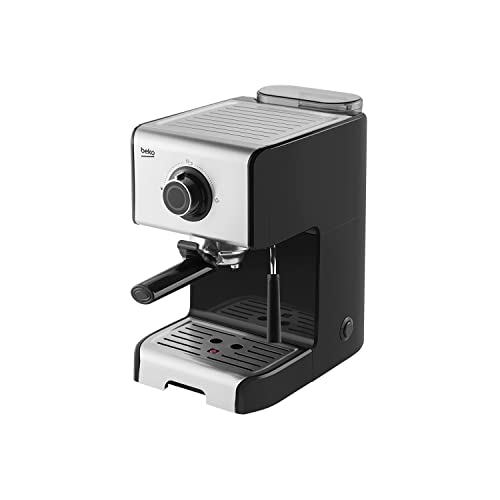Espresso Maker - A Must-Have For Home Baristas
Espresso is a dark, strong drink that is created by pushing hot coffee through finely ground coffee grounds that are tightly packed. It is the base for many popular coffee drinks at the cafe.
A barista, also known as an "espresso maker" controls a number of variables to make a fantastic cup. This includes the temperature of the water and its pressure as well as how tightly packed the coffee is.
Origins
The espresso machine is a gadget which makes use of high pressure to push small amounts of water close to boiling through finely ground beans. The espresso is stronger, more concentrated and served in smaller cups. It's an excellent choice for those who prefer a strong cup of joe but need it urgently!
In the 19th century the first espresso machines were invented. The coffee industry was a major business, but brewing it took too long. People were impatient and needed to have a cup of coffee in a hurry!

Angelo Moriondo of Turin patented one of the first coffee machines in 1884. The machine's name was "New steam machine, for the economical and rapid preparation of coffee beverage. Method A." Moriondo."
The Milanese manufacturers Luigi Bezzerra and Desiderio Pavoni developed and improved the machine. They introduced the portafilter as well as multiple brewheads, as well being other inventions that are still associated with espresso makers today. The machine was dubbed the Ideale and it impressed the crowds at the 1906 Milan Fair. Nine out of ten Italian homes have Moka Pots. Moka Pot.
Variations
Espresso's flavor is more concentrated than coffee, and it pairs well with milk and other ingredients to create café favorites such as cappuccinos or lattes. Its acrid flavor is evident in recipes for baked goods marinades, other dishes and more.
There are four kinds of espresso machines: semi-automatic super-automatic and manual lever. Each has a distinct way of creating pressure for extracting the espresso.
A manual lever machine employs a mechanical piston that presses water through the ground. It's a great alternative to human control and mechanized consistency. You still have the grind, tamp, and pull shot for yourself however, you can control water temperature and pressure much better.
Moka pots are a second manual espresso maker that works similar to modern pump-driven espresso machine. Inside an airtight tank, boiling water produces steam, which is then forced through the bottom chamber into a filter basket containing ground coffee, and then into a metal filter, where it funnels into the top cup. They're cheaper than a full-sized espresso machine, but they're able to only hold up to 1-1.5 bars of pressure, which is less than the ideal setting for brewing espresso.
Ingredients
With a bit of time and practice, espresso makers can help home baristas craft cafe favorites like cappuccinos, lattes and flat whites. You can also add flavored syrups or extracts to espresso shots for an indulgent drink like the espresso martini.
espresso maker barista to make a great cup of espresso include high-quality coffee beans, fresh milk and sugar. To ensure a consistent extraction, choose coffee beans with a special espresso label. Blend them finely. You can try different roasts until you discover the one you like the best.
You'll need a burr grinder to grind the beans into an even texture. The espresso machine is equipped with an in-line portafilter that holds the grounds, and the tamper is used to pack in the coffee into a tightly packed.
You'll also require an espresso cup set, as well as a steamer to make the silky aerated-milk so characteristic of espresso drinks. Some machines come with steam wands that aid in the process. You'll also need to descale your machine regularly that involves running water and vinegar solution through the system.
Techniques
Espresso Brewing is the process of creating pressure that allows for rapid extraction of intense flavor from finely ground dark-roasted coffee that is tightly packed into a 'puck. This method of brewing results in the strong coffee shot referred to as espresso. When made well espresso is a delicious crema (or dense foam) on top.
Most espresso makers use high-pressure water to force through finely ground coffee under extreme heat. This differs from the Moka Express, which uses heat to clean coarsely ground coffee. This produces an espresso like beverage that is diluted in milk or water to make other beverages, such as lattes or cappuccinos.
While the Moka Express is a simple and low-cost device, other espresso machines are complex, expensive, and offer numerous beverages. The most well-known machines, however, are Italian-designed lever machines which use spring-loaded arms that release hot water from a cylinder to a portafilter. The barista can alter variables like water temperature and grind size shot by shot to get the most optimal results. These machines were essential in bringing espresso to greater recognition throughout Italy and Europe.
Equipment
A high-quality espresso maker needs to be able to separate soluble and insoluble solids from finely packed, tightly ground coffee. This process is assisted by pressure and controlled variables, like temperature and grind size. The flavor is also a consequence of a myriad of factors such as the beans used and how they are brewed.
There are many different kinds of espresso machines, however the semiautomatic is most commonly used. It uses an electric pump to stir the water and force it through the grounds. The user can also perform the grinding and tapping. These machines are the most affordable, however they're not as reliable as spring pistons or other designs that are manual.
The higher priced lever models have a calibrated piston that does the work. They are a little more tolerant than a spring piston machine however, they require some experience to operate properly. They usually require a lot of maintenance, requiring you to heat and de-assemble the portafilter and piston every time.
